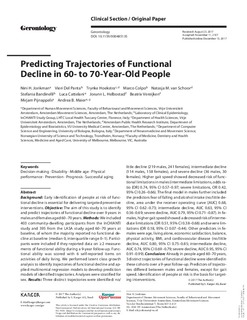| dc.description.abstract | Background: Early identification of people at risk of functional decline is essential for delivering targeted preventive interventions. Objective: The aim of this study is to identify and predict trajectories of functional decline over 9 years in males and females aged 60–70 years. Methods: We included 403 community-dwelling participants from the InCHIANTI study and 395 from the LASA study aged 60–70 years at baseline, of whom the majority reported no functional decline at baseline (median 0, interquartile range 0–1). Participants were included if they reported data on ≥ 2 measurements of functional ability during a 9-year follow-up. Functional ability was scored with 6 self-reported items on activities of daily living. We performed latent class growth analysis to identify trajectories of functional decline and applied multinomial regression models to develop prediction models of identified trajectories. Analyses were stratified for sex. Results: Three distinct trajectories were identified: no/little decline (219 males, 241 females), intermediate decline (114 males, 158 females), and severe decline (36 males, 30 females). Higher gait speed showed decreased risk of functional limitations in males (intermediate limitations, odds ratio [OR] 0.74, 95% CI 0.57–0.97; severe limitations, OR 0.42, 95% CI 0.26–0.66). The final model in males further included the predictors fear of falling and alcohol intake (no/little decline, area under the receiver operating curve [AUC] 0.68, 95% CI 0.62–0.73; intermediate decline, AUC 0.63, 95% CI 0.56–0.69; severe decline, AUC 0.79, 95% CI 0.71–0.87). In females, higher gait speed showed a decreased risk of intermediate limitations (OR 0.51, 95% CI 0.38–0.68) and severe limitations (OR 0.18, 95% CI 0.07–0.44). Other predictors in females were age, living alone, economic satisfaction, balance, physical activity, BMI, and cardiovascular disease (no/little decline, AUC 0.80, 95% CI 0.75–0.85; intermediate decline, AUC 0.74, 95% CI 0.69–0.79; severe decline, AUC 0.95, 95% CI 0.91–0.99). Conclusion: Already in people aged 60–70 years, 3 distinct trajectories of functional decline were identified in these cohorts over a 9-year follow-up. Predictors of trajectories differed between males and females, except for gait speed. Identification of people at risk is the basis for targeting interventions. | nb_NO |

